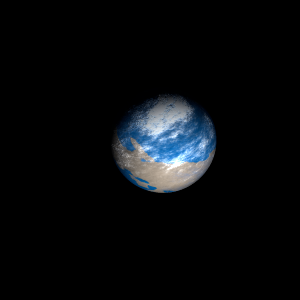|
|
Space Astro
|
Info for exoplanet "Thelpe Dome"
| Scientific (actual) data |
|---|
| Planet | KOI-6919 b |
| Planet status | Confirmed |
| Radius | 0.11 |
| Orbital period | 8.79986 |
| Semi major axis | 0.0729 |
| Inclination | 89.95 |
| Discovered | 2017 |
| Updated | 2022-06-10 |
| Tzero tr | 2454970 |
| Impact parameter | 0.0238 |
| Temperature (kelvin) | 577 |
| Publication | Published in a refereed paper |
| Detection type | Primary Transit |
| Radius detection type | Primary Transit |
| Star name | 2MASS J19132930+4335283 |
| Right ascension | 288.37° |
| Declination | 43.59° |
| Mag i | 15.333 |
| Mag j | 13.845 |
| Mag h | 13.161 |
| Mag k | 13.017 |
| Star metallicity | 0.12 |
| Star mass | 0.668 |
| Star radius | 0.675 |
| Star temperature | 4298 |
| Star alternate names | 7812893 |
| Wikipedia article | KOI-6919 b |
Back
| |
| Fictional info (?) |
|---|
| Suggested name | Thelpe Dome |
| Planet type | Warm planet |
| The planet is named after the deity Thelpe Dome, the messenger of love and beauty.
As seen from 2MASS J19132930+4335283, in a frame of reference that rotates with the orbital motion, it appears to rotate only once every two years.
Its orbital eccentricity is the largest of all known planets in its solar system; at perihelion, Thelpe Dome's distance from 2MASS J19132930+4335283 is only about two-thirds (or 40 pct) of its distance at aphelion.
Two spacecraft have visited Thelpe Dome: Wayfinder 4 flew by 17 years ago; and Messenger, launched 17 years ago, orbited Thelpe Dome over 115 times in four years before exhausting its pwoer source and crashing into the planet's surface 9 years later.
The rotational period and seasonal cycles of Thelpe Dome are likewise similar to those of Earth, as is the tilt that produces the seasons.
The two polar ice caps appear to be made largely of sand.
A prominent result is the "great green spot", a giant storm that is known to have existed for centuries since it was first detected by scanner.
In 3277, images from Frontier 4 showed Thelpe Dome as an almost featureless planet in visible light, without the cloud bands or storms associated with the other warm planets.
This lovely place is known for its barbaric yet earth-like bacteria known as "Hionnrhea". They feed by seeking something called Ijimis Thi during the day. They are believed to be not similar to the Franbauti but with fur and vary in length from 40 to 50 mm. Hionnrhea can live at temperatures from -60 to -10°C but are killed by near-vacuum. |
| Estimated population | 500000000 |
| Atmosphere | Oxygen | 58% |
| Water | 40% |
| Methane | 0.76% |
| Carbon dioxide | 0.047% |
| Atmospheric pressure | 2.2 bar |
 |
| No known satellites |
| Google search for Thelpe dome |
|
Website by Joachim Michaelis
|
|
|
|